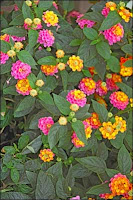Black-eyed Susan Rudbeckia var sullivantii fulgida Goldsturm

This little gorgeous perennial Black-eyed Susan was sent to me from the grower to try it out. Look for this specific one if you would like to have a mid-size perennial Rudbeckia that cheers up the garden, returns reliably year after year, and spreads very slowly to fill in a patch of ground. This is such a polite little plant - no seeding around everywhere. It's been in the ground three years and the 4-inch pot size plant has spread to make a 2-foot wide plant with offsets. When the flowers fade they become practically black - gorgeous to my eye. Do not pull off the flowers when cleaning up the plant, like you would a zinnia. Entire stems came off in my hand when I did it that way. Better to take a pair of clippers out and do it correctly. 'Goldsturm' was the 1999 Perennial Plant of the Year by The Perennial Plant Association. It should be in full sun but ours is in part sun. Hardy in zones 4 to 9. Seedaholic sell...





.JPG)
